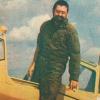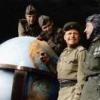-
Posts
2,012 -
Joined
-
Last visited
Content Type
Events
Profiles
Forums
Media Demo
Status Updates posted by KRK4m
-
Sorry for being so late for the T-34 GB, but 3 days ago I just have received a large parcel of Ukrainian UM 1/72 AFV kits including (among others) also the T-34 and SU-100.
Could I join the pack still?
Cheers
Michael
-
Hi Jamie,
There are seven post-war USN carriers in my stash, namely the 1/700 Antietam (Dragon), Kitty Hawk (Fujimi), Nimitz (Trumpeter), Nassau (Italeri) and Wasp (Hobby Boss) plus 1/720 Saratoga (Italeri) and Enterprise (Revell). And every manufacturer uses different names for the colours that look roughly the same. So my question is whether were there any changes in USN carrier camouflage after 1955 or should all these six vessels look uniform? Is the Hobby Boss "dark gray" the same colour as Italeri "gunship gray", Revell "medium gray" and Fujimi "engine gray"? Are the (used for the verticals) Dragon "light gull gray", Italeri "gull gray", Revell "steel gray" and Trumpeter "navy gray" just various (kit maker) names for the same hue? Is it true that somewhere between 1955 and 1980 true Black was used for the angled landing path?
And another question follows on - what colour should be used for the deck of the CV-41 Midway during her 1950 Mediterranean deployment? A friend of mine builds the small 1/72 diorama including the VF-72 F8F-1B, the VF-74 F4U-4 and the VC-12 TBM-3E. Was the carrier deck also "dark/gunship/engine gray" already in 1950?
Cheers
Michael
-
Some 45 years ago I have seen the copy of "Scale Modeler" featuring the model of PBY-5 in so-called Asiatic fleet scheme invented by Admiral Hart men in Philippines. The owner of this copy - a long time friend of mine - died of heart attack few years ago and his widow destroyed (or simply thrown out) all his tremendous library...
Generally the aircraft followed the scheme well known from b&w pictures of PatWing 10 PBY-4s (and interpreted as 3 shades of blue-gray topsides plus a light grey bottom by Academy in their 1/72 PBY-4 kit), but if nobody knows for sure what the three topsides colors really were here one color seemed to be fixed - the Blue Gray as the PatWing 10 PBY-5s fighting over the Philippines and NEI in January 1942 were ex-VP-22 aircraft pictured a month before in Hawaii featuring then-standard M-485 over M-495 camouflage.
Do you mean that there was enough time and paint to apply the (otherwise standard for the PatWing 10) "Philippines camo" on the VP-22 aircraft recently acquired? Have you ever seen the early '70s Scale Modeler article mentioned above? Or maybe there are some photos confirming the scheme featured by the model depicted there?
Thank you in advance
-

Thanks for your question - you've touched on a subject that has interested me for many years - I'll give you my opinion, since I don't have proof either way...
First note is just a general note about M-485 and M-495 -- for many years modelers have thought those specs represented specific colors, which they didn't. M-485 was just a spec for camouflage lacquer, regardless of color; M-495 was the spec for camouflage dope. So Blue Gray lacquer applied to metal surfaces was M-485, while Blue Gray dope applied to fabric surfaces was M-495. The same was true of Light Gray lacquer and dope, and the insignia color lacquers and dope, black lacquers and dope, and so on. I mention this just to make sure we're talking the same language about these colors.
The earliest record I've seen of PatWing 10's Catalina camouflage was a reconnaissance photo dated 26 May 1941; all six PBYs in the photo were camouflaged in a disruptive pattern. PatWing 10 was in the Asiatic Fleet, whose ideas about camouflage were independent of the Pacific Fleet's (or Battles Force's) ideas. I believe that PatWing 10 might have used a version of a 1935 camouflage cited on page 31 of Jack Elliott's Monogram Guide Volume 1 - Dark Green-Yellow, Medium Blue-Green, and Light Purple-Blue. I've no proof, but those colors made sense for the murky Philippine waters, and that's what I think I'm seeing in the pix.
One last thing - you asked, "Do you mean..." but I'm afraid I don't have the memory I once had. (A bit too much time without oxygen a few years ago.) I'm not sure what I said, or when I said it, but I apologize for any confusion.
Cheers,
Dana
-




